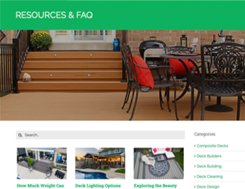
How to Build a Deck – Part #1
Considering building your own deck but aren’t sure where to start? Throughout this series, we will present step by step instructions on how to build a deck.
Step #1 in the process, is to obtain the materials needed for the job.
Deck building requires a lot of varied materials. This can be a lot for a DIY deck builder to figure out. Here are a few things you should know when shopping for, or accepting a delivery of building materials.
How to Visually Inspect Materials
There are four essential qualities that need to be inspected before accepting a delivery or purchasing deck materials.
- Dimensions of the material must be correct.
- Materials should conform to certain standards in shape, especially lumber.
- The appearance of trim and deck top materials is essential. Check that they are in good repair.
- Structural integrity should be consistent.
How to Check Dimensions
There are three dimensions that matter when inspecting lumber. Hardware and other materials often have important dimensions as well but are fairly standard and can be returned if they are wrong. Lumber is often unreturnable or carries a hefty restocking fee. Getting it right saves time and money.
- The thickness of the board should be consistent from one to the next in lumber that is the same size.
- The width of the board should also be consistent within the same size.
- The length of the board should be at least the length advertised, sometimes a quarter to half-inch longer. Great for cutting off factory ends.
Understanding Nominal Dimensions
Lumber is named for its “nominal” dimensions, which are typically larger than the actual dimensions of the board. This is because the piece is rough cut to the dimension it is named for. For example, a 2X4″ is smoothed on a planer to get the actual dimensions, which is smaller.
- As a standard rule, the finished dimension of lumber under one inch thick is named for its actual dimension and should be very close to that thickness.
- The finished dimension of lumber one inch thick is approximately ¾ inch thick, having ¼ inch shaved off of the top and bottom faces in the milling process.
- The finished dimension of lumber more than one inch thick is approximately ½ inch thinner than its named or “nominal” dimension. So a four by four is approximately 3 ½ inches thick.
- Dimensional lumber is ½ inch narrower than its nominal width. So a two by four, or one by four is 3 ½ inches wide.
- Sheet goods, such as plywood, are named for their actual dimensions.
- Lumber comes in lengths with two-foot intervals starting with six or eight feet, running up to 16 or 20 with longer pieces available by special order.
Inspecting Your Lumber
All lumber should be the same thickness and width within a single board size.
Check enough boards to get a representative sample. It is not necessary to check each board. Dimensions are typically very consistent. Identify the size of each group of boards to ensure you have the right materials.
Whether you create your own material list or have the lumber supplier do one for you, use your materials list as a checklist. Mark off each item as it is verified and counted. You will also want to check for the following factors.
- Twisted, curved, or “cupped” boards. Slight curvature can be straightened in construction. Anything that will not stack properly should be rejected.
- Checks, splits, or cracks more than an inch or two long and visible on both faces indicate structural weakness; reject this lumber.
- Framing lumber with some bark or roughness at the edges is fine. If it is extensive or makes the board hard to use, reject it.
- Decking material and trim should be as close to ideal as possible. Reject material that you find unacceptable visually. You may have to accept the best available material in some cases. When using low maintenance decking materials, a little dirt is acceptable, but scratches are now.
Other Materials
Check the dimensions and quantity of fasteners, bolts, brackets, and other hardware. Labelled sealed boxes can be checked by their label. Open bin hardware should be checked for correct dimensions.
Reject rusted, corroded or visibly damaged hardware. The strength of your deck will rely on the fasteners and hardware. As with lumber, use your materials list and check each item for quantity and mark it off your list. It is always best to buy a few extra of everything. One extra bolt could save a half-day of going after more hardware.

































